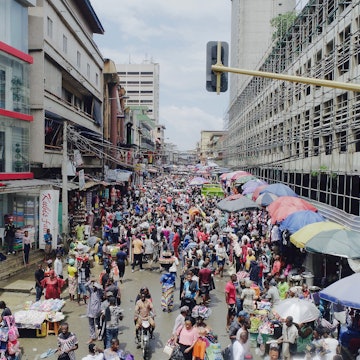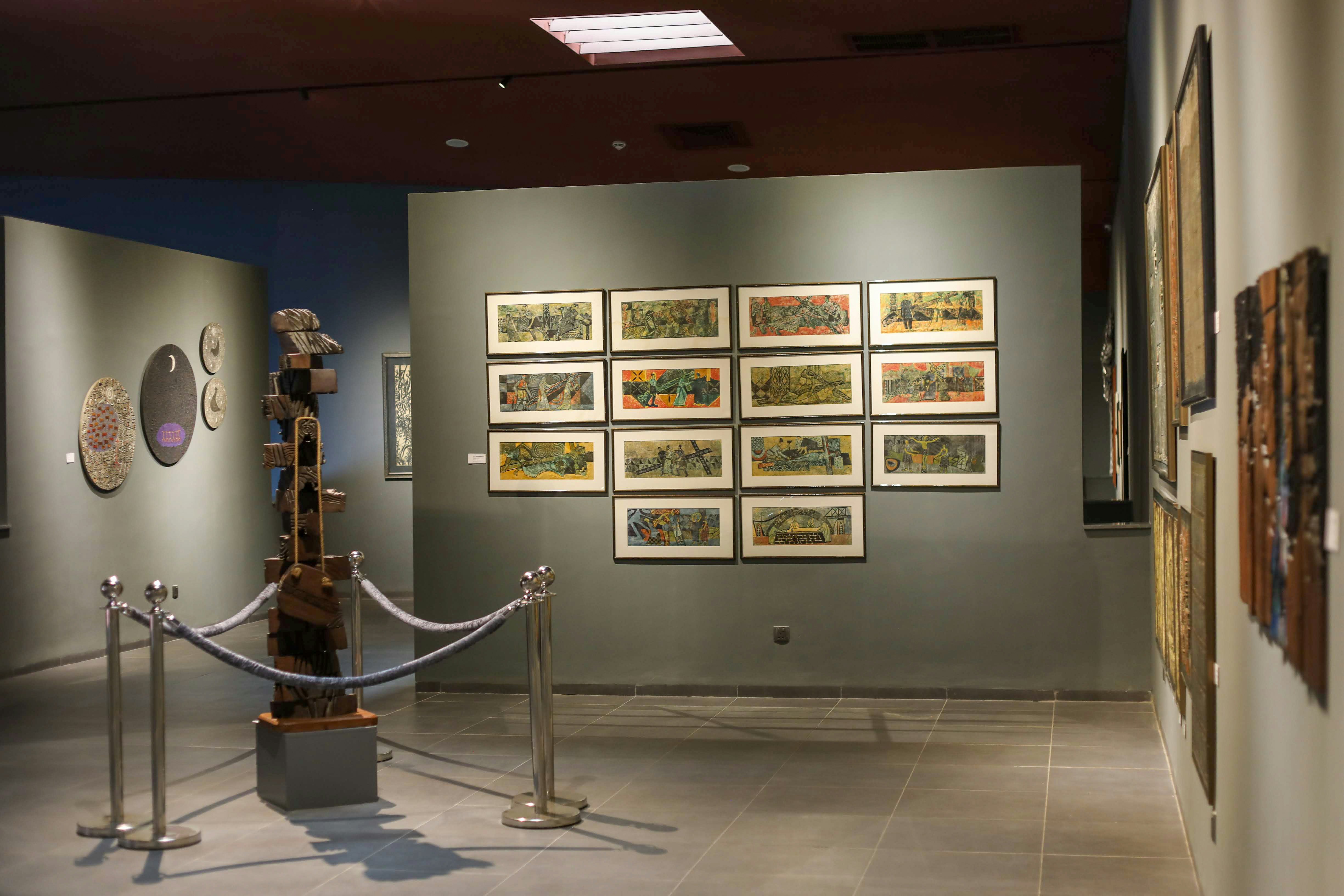

Posters from Lagos Photo Festival © Reuters / Alamy
Art critic Emmanuel Iduma finds his way out of a pandemic rut with a visit to the Yemisi Shyllon Museum of Art in the outskirts of Lagos.
After nearly seven years abroad, I returned home to Lagos in December 2019. Three months later, due to the COVID-19 pandemic, the Nigerian government announced a lockdown. The city entered a state of inaccessibility that lasted nearly six months. Parts of the city that were ordinarily cacophonous with the honks of impatient drivers and the bustle of shoppers, settled into an uneasy silence. Food could only be ordered in; at restaurants across the city, tables were stacked in dark corners. Even the never-ending stream of construction workers vanished, making the empty, unroofed buildings seem haunted.
In those months, I often recalled the pleasures I had taken for granted as a writer and adjunct professor at the School of Visual Arts in New York City, namely the frequent visits to museums and galleries. I felt the distinct sense of living in a time outside time, as though the version of myself that was suddenly in Lagos was irreconcilable with who I had been elsewhere.

The art scene that went digital in Lagos
Yet, soon enough, I grew content to be in Lagos without seeing art, an activity that felt suddenly unnecessary during a time of existential, viral threats. Even when things started returning to normal, and galleries and art shows allowed for access again, I limited my experience to browsing from my computer screen. I spent hours clicking through the 2020 editions of ART X Lagos and the LagosPhoto Festival, both of which, although continental in scope, were fully virtual.
Then, on a day in early October 2021, I found myself browsing the website of the Yemisi Shyllon Museum of Art, a new private museum in the outskirts of Lagos. I wondered if its collection – a wide array of pieces spanning multiple eras of Nigerian art – could be the perfect reintroduction to art in the city I now called home. By the morning of my drive, the streets of Lagos had regained their pre-pandemic vigor.

The winding route to Yemisi Shyllon Museum of Art
Twenty minutes into my ninety-minute journey, as I made my way to the edge of the city, the traffic lights disappeared, giving way to free-for-all intersections that took equal parts patience and daring to pass. These suburbs were dominated by fenced-in communities. Grand gated entryways bore the names of sprawling mini-estates: Diamond Estate, Crest Estate, Beachwood Estate. Elsewhere, giant billboards advertised the gated communities to come, as well as the outrageous sums required as deposits for buy-ins. Pedestrians carried on, hurrying across the street ahead of oncoming traffic. I was overwhelmed, given all the time I had spent inside. But it was also a delight to drive farther through Lagos than I had since I returned. Each inch of the 40-plus kilometers felt like a reward for the agonizing seclusion of the previous year.
And then, my navigation app said I was fifteen minutes away from Pan-Atlantic University, where the Yemisi Shyllon Museum is located. The map indicated that I had to make a U-turn at some point ahead, but everywhere I looked appeared to be under construction – Lagos is a city perpetually being built. A man wearing a construction vest suggested I make my way on foot, since, from where we stood, and given the state of the road, it was impossible to drive into the university.
I walked for about ten minutes over marshland, only to fall into a muddy hole and promptly turn around. The man who had sent me on my walk to nowhere now pointed me to a tap where I could wash my shoes and feet. By the time I eventually arrived at the museum – not on foot, but in my car – I was 30 minutes late for my tour.
A guided tour of over 1000 works
The museum is a broad expanse of ruby-red brickwork, windowless and bright against the blue sky. The only opening to the outside world is an entryway positioned close to the edge of the cube-like structure. The university itself is a modest complex; three buildings stand just east of the museum, encircled by seemingly endless tracts of undeveloped land.
I approached a woman sitting by herself on a long information desk. I told her I had signed up for a tour. “Interesting,” she said, as if surprised. In a rehearsed but genial fashion, she proceeded to describe the contents of the museum. Guided tours are available for an additional fee throughout the day and can be reserved here.
Gifted by Prince Yemisi Shyllon – a lawyer, engineer, and stockbroker – the collection includes over 1000 works. Isioma, my guide, offered information about the trajectory of our tour: we’d begin with the gallery on the ground floor, largely devoted to an ongoing exhibition titled Invincible Hands, featuring contemporary art by Nigerian women. Then we’d make our way to the gallery above, where there was a selection of works from the permanent collection.

Reconnecting with art, post-lockdown
Like a kid surprised at their better-than-expected test scores, I was pleased as I walked with Isioma around the ground floor gallery. The range was eclectic, featuring paintings, sculptures, collages and photographs by up to 38 artists. Isioma demanded engagement, asking me from time to time to guess what material had been used for certain artworks if one was clay or paper, wood or bronze. Sometimes I imagined that her enthusiasm, as she attended to a single visitor, compensated for the lack of a larger crowd. I saw no other patron in any of the galleries during the time she took me around. Visiting a museum in the middle of a workday—in a city of no fewer than 23 million people, and in a country with the third-highest joblessness rate in the world—was a luxury few could afford.
But this, in a sense, was a work trip for me. I hoped that it could inspire future writing, that it could push me to consider art as preeminent, like I had before the lockdowns. And there was something else. Art has a way of illuminating your priorities. When I looked, for instance, at Abayomi Barber’s “Ola II” – a dark, bronze bust of a woman glancing sidelong at the distance with a tender, determined poise – I thought of my wife. I felt grateful for the effortlessness with which we organized our days, waking up to each other and working from home. I wished she was there with me, and so each photo I took of what I had seen was sent to her in preparation for the time we’d return together.

After Isioma and I made our way up a set of stairs bathed in warm light, I became even more amazed by the scope of the collection. I immediately recognized paintings by Aina Onabolu, a painter born in 1882, known for his work in portraiture, and often called the father of modern Nigerian art. There was a piece by Ben Enwonwu, once commissioned to make a bronze sculpture of Queen Elizabeth II. For the first time since I returned to Lagos from New York, I was surrounded by Nigerian art, without the mediation of a screen or the distance of an ocean. It felt right.
After she had taken me around, Isioma left me to wander alone. As I took more photographs of the artworks, circling the galleries over and over again, standing face to face with Benin Bronzes and Nok terracotta, I felt skepticism creep in. The museum was open to all, yet how many cared to make the trip? Was I an exception to the rule in a city I call home?
Hope for a more accessible future
Then, shortly before leaving, I spoke with Michael Oseghale, the museum manager. It was an out-of-the-way place, he admitted, but he hoped that since an airport was being built nearby, the Ibeju-Lekki suburb would continue to expand, and the museum would attract new neighbors. The museum, he continued, was affiliated with a university without an art department, and so they catered to a wide array of disciplines, taking any opportunity to augment the learning experience of students. Graphic design students could learn about color combinations using paintings, and accounting students could learn about asset valuation by studying Benin Bronzes, he said.

Sharing stories of Nigerian artists
Oseghale reassured me not just with his knowledge but with his awareness of the stakes of being a museum manager in Lagos. I sensed genuine anger when he recalled that a student at the university, visiting the museum, had said, “I didn’t know Nigeria had artists.”
“What we do here is tell our own stories with the artworks that we have,” Oseghale said.
My own story was best evoked in one of the paintings in the Invincible Hands exhibition: Wura Natasha-Ogunji’s “Conditions for Flight.” It is a towering, abstract work painted with oil; an array of colors spread unevenly across a large sheet of paper. Looking at it felt akin to watching a nimbus move across the sky. It fit with how I thought of the past year, most of which I spent indoors: full of signs for what was to come, like the moment between the crack of thunder and a downpour. When I pulled out of the university gate, it began to drizzle.
You might also like:
Africa: what to expect on an overland tour
Where to go on your first safari in Africa
Safari animals: the story of elephants (and the best places to see them)
Lagos is on our 2022 Best in Travel list. For more stories from some of the world’s most exciting destinations click here.
Safety recommendations and restrictions during a pandemic can change rapidly. Lonely Planet recommends that travelers always check with local authorities for up-to-date guidance before traveling during Covid-19.













